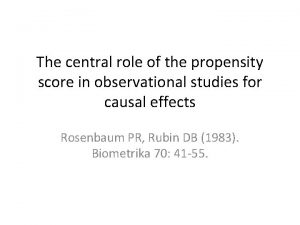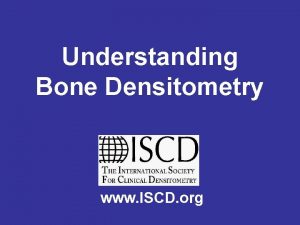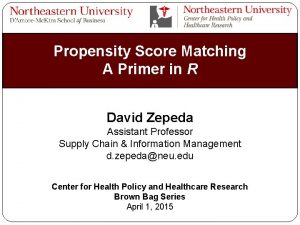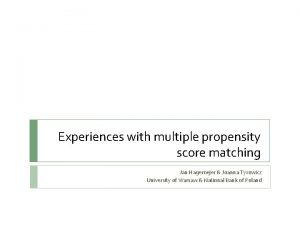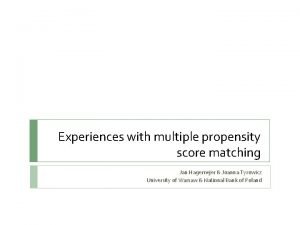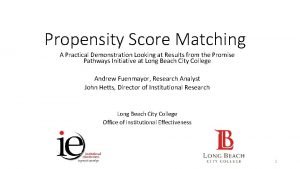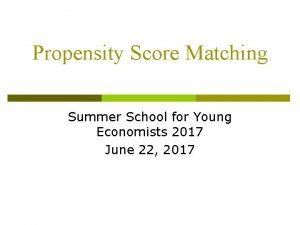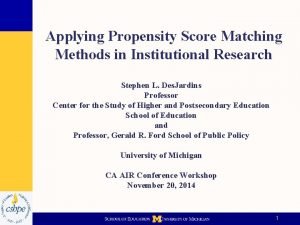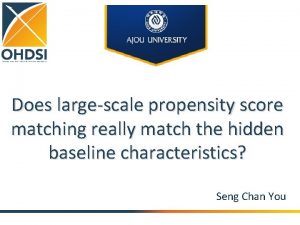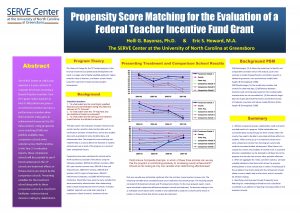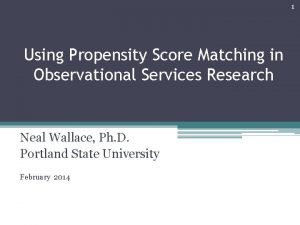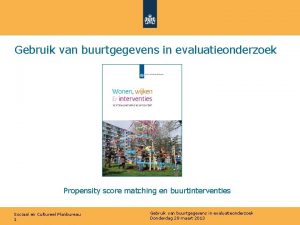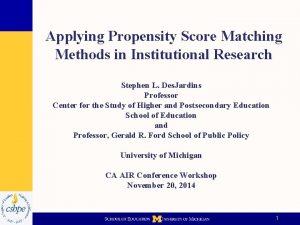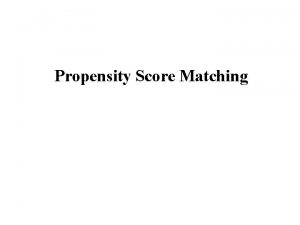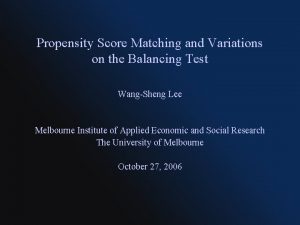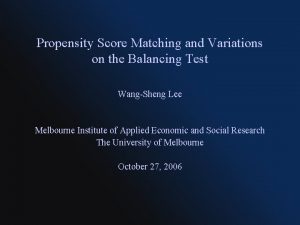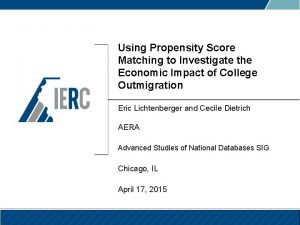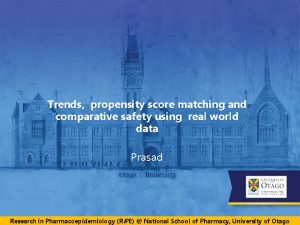Matching Procedures Propensity Score Hctor Lamadrid Center for


























- Slides: 26

Matching Procedures: Propensity Score Héctor Lamadrid Center for Population Health Research National Institute of Public Health, Mexico

What is matching for? § In an ideal setting, we will always have a random assignment of the treatment. § This makes estimating the programme effect straightforward and relativley easy… § However: Often this is not possible, or we are called to evaluate once the programme is running… § What to do? We always need to look for the best possible proxy of the counterfactual

Matching § Suppose that individuals are voluntarily enrolling (or not enrolling) in a programme. § It is very likely that those who decide to enroll are very different to those who don’t § A simple comparison between both groups will surely be very biased.

Matching § What to do then? § Take one subject A, who enrolled…. § Look for other subject who is almost identical to subject A, but who DID NOT ENROLL, lets call him subject B. He will be our proxy of the counterfactual § Calculate the difference in the outcome between both subjects. § Repeat for all the treated subjects… § Voilá! We get an estimate of the Average Treatment Effect!

Matching § All this sounds great but note that subject B must be almost identical to A, that means we desire both to have the exact same values of MANY variables related to the outcome.

Matching on 1 variable Example 1: pairs=4

Matching on 3 variables Example 2: ? With only 3 covariates, and with only 4 possible values each, we have 43=64 possible covariate patterns: it is very hard to get a good match! Dimensionality problem

Matching § So we could try to match on several important variables but adding more variables makes it exponentially more difficult to find a match. § So… Rosenbaum & Rubin came up with this idea of collapsing all information of covariates in a single measure: § The “Propensity Score”

The propensity score § Employs a predicted probability of group membership—e. g. , treatment vs. control group-based on observed predictors, usually obtained from logistic or probit regression to create a counterfactual proxy. § Propensity scores may be used for matching or as covariates in a regression model—alone or with other matching variables or covariates.

Propensity Score • The propensity score is the estimated probability that an individual participates in the programme given a set of observable characteristics X. p(X)=Pr(T=1|X) • It can be thought of a “summary” of multiple factors that may make the comparison groups (treatment & controls) different • As any other probability, it lies between the values 0 and 1.

Propensity Score • Useful for matching: Instead of matching on an enormous set of covariates, we can match two individuals who have the same probability of being enrolled in the programme! • We have to make a couple of important assumptions: • Conditional on X, the treatment assignment is independent of the potential outcomes. • There is a common support area (an overlap of the distribution of p(X) in the treatment & control groups)

Regions of common support

PS Matching § Disadvantages: § Large samples are required § Group overlap must be substantial (which often reduces the effective sample size) § Most important: Bias may remain because matching only controls for observed variables (to the extent that they are perfectly measured), and not for unobservable.

General procedure • STEP 1 Obtain the propensity score • Run logistic or probit regression: • Y=1 if subject participates in the programme, else Y=0 • Get estimated probabilities • X’s need not be affected by the programme (use baseline information) • STEP 2 Select non participants and match them to participants on the basis of p(X) similarity. (There are several algorithms to do this)

§ STEP 3: § Check balance between the samples § If samples are not balanced return to revise the PS model Pr(T=1 | X): include more variables & interactions

§ STEP 4 Estimate the ATT:

Different ways to determine w: • nearest neighbor: k nearest neighbors: • kernel weights:

• local linear matching:

Implementation in STATA • psmatch 2: psmatch 2 d, pscore(px) out(y) options for matching (one-to-one, K nearest neighbors, kernel, radius, spline, llr, mahalanobis) • attnd, atts, attnw, attk, attr • nnmatch: nnmatch y d x 1 (only nearest neighbor) • pscore: balance alternative to estimate PS and check

• psmatch 2: advantages: several possible matching algorithms disadvantages: needs to use bootstrap to correctly estimate standard errors • nnmatch: advantages: Exact estimation of the standard error disadvantages : Only matches using the nearest neighbour algorithm

Sample balance • After matching we need to check if … • The average values of X are approximately equal in the treatment & control groups. This is supposed to verify the Conditional Independence Assumption. • In STATA we have: ü pstest x 1 x 2 x 3, t(d) ps(pscore) support(varname)

Issues to have in mind • Number of pairs: – More pairs: • ↑ bias • ↓ variance – Replacement: • with: – ↑ variance – ↓ bias • without : – ↑ bias – ↓ variance

Recomendations for a good PSM 1. Identify well all the mechanisms that might be affecting participation in the programme. 2. Use the same data source to identify participants & nonparticipants. 3. Try to identify a sample with a large enough sample of eligibles not participating in the programme. 4. Try to not over-specify the PS model. Ironically a perfect participation prediction is not good! No common support: no matching!

Advantages of PSM • Avoids the linearity assumption required by OLS or other regression models (no functional form is assumed). • Easy to implement • Robust

Disadvantages • Does not deal with unobservables • Requires a common support: • No common support, no matching • Requires a lot of information to model the participation process

 Propensity score theorem
Propensity score theorem Propensity model meaning
Propensity model meaning Tax multiplier formula
Tax multiplier formula What is iscd
What is iscd T-score statistics
T-score statistics Fspos
Fspos Novell typiska drag
Novell typiska drag Tack för att ni lyssnade bild
Tack för att ni lyssnade bild Returpilarna
Returpilarna Shingelfrisyren
Shingelfrisyren En lathund för arbete med kontinuitetshantering
En lathund för arbete med kontinuitetshantering Särskild löneskatt för pensionskostnader
Särskild löneskatt för pensionskostnader Personlig tidbok fylla i
Personlig tidbok fylla i A gastrica
A gastrica Densitet vatten
Densitet vatten Datorkunskap för nybörjare
Datorkunskap för nybörjare Stig kerman
Stig kerman Debattartikel mall
Debattartikel mall Autokratiskt ledarskap
Autokratiskt ledarskap Nyckelkompetenser för livslångt lärande
Nyckelkompetenser för livslångt lärande Påbyggnader för flakfordon
Påbyggnader för flakfordon Formel för lufttryck
Formel för lufttryck Offentlig förvaltning
Offentlig förvaltning Bo bergman jag fryser om dina händer
Bo bergman jag fryser om dina händer Presentera för publik crossboss
Presentera för publik crossboss Vad är ett minoritetsspråk
Vad är ett minoritetsspråk Bat mitza
Bat mitza
